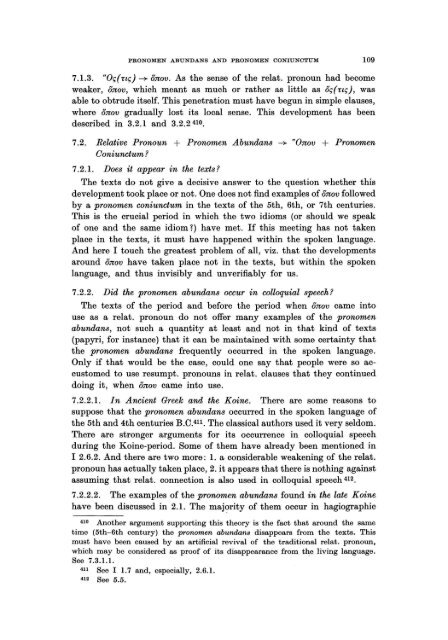Pronomen Abundans and Pronomen Coniunctum. A ... - DWC
Pronomen Abundans and Pronomen Coniunctum. A ... - DWC
Pronomen Abundans and Pronomen Coniunctum. A ... - DWC
You also want an ePaper? Increase the reach of your titles
YUMPU automatically turns print PDFs into web optimized ePapers that Google loves.
PRONOMEN ABUNDANS AND PRONOMEN CONIUNCTUM 109<br />
7.1.3. "Oç(Tlç) ~ onov. As the sense of the relat. pronoun had become<br />
weaker, onov, which meant as much or rather as little as oç(Tlç), was<br />
able to obtrude itself. This penetration must have begun in simple clauses,<br />
where onov gradually lost its local sense. This development has been<br />
described in 3.2.1 <strong>and</strong> 3.2.2 41 °.<br />
7.2. Relative Pronoun + <strong>Pronomen</strong> <strong>Abundans</strong> ~ "Onov + <strong>Pronomen</strong><br />
<strong>Coniunctum</strong>?<br />
7.2.1. Does it appear ~n the texts?<br />
The texts do not give a decisive answer to the question whether this<br />
development took pI ace or not. One does not find examples of onov followed<br />
by a pronomen coniunctum in the texts of the 5th, 6th, or 7th centuries.<br />
This is the crucial period in which the two idioms (or should we speak<br />
of one <strong>and</strong> the same idiom 1) have met. If this meeting has not taken<br />
place in the texts, it must have happened within the spoken language.<br />
And here I touch the greatest problem of all, viz. th at the developments<br />
around onov have taken place not in the texts, but within the spoken<br />
language, <strong>and</strong> thus invisibly <strong>and</strong> unverifiably for us.<br />
7.2.2. Did the pronomen abundans occur in colloquial speech?<br />
The texts of the period <strong>and</strong> before the period when onov came into<br />
use as arelat. pronoun do not offer many examples of the pronomen<br />
abundans, not such a quantity at least <strong>and</strong> not in that kind of texts<br />
(papyri, for instance) that it can be maintained with some certainty that<br />
the pronomen abundans frequently occurred in the spoken language.<br />
Only if that would be the case, could one say that people were so accustomed<br />
to use resumpt. pronouns in relat. clauses that they continued<br />
doing it, when onov came into use.<br />
7.2.2.1. In Ancient Greek <strong>and</strong> the Koine. There are some reasons to<br />
suppose that the pronomen abundans occurred in the spoken language of<br />
the 5th <strong>and</strong> 4th centuries B.C. 411 . The classical authors used it very seldom.<br />
There are stronger arguments for its occurrence in colloquial speech<br />
during the Koine-period. Some of them have already been mentioned in<br />
I 2.6.2. And there are two more: 1. a considerable weakening of the relat.<br />
pronoun has actually taken place, 2. it appears that there is nothing against<br />
assuming that relat. connection is also used in colloquial speech 412.<br />
7.2.2.2. The examples of the pronomen abundans found in the late Koine<br />
have been discussed in 2.1. The majority of them occur in hagiographic<br />
410 Another argument supporting this theory is the fact that around the same<br />
time (5th-6th century) the pronomen abundans disappears from the texts. This<br />
must have been caused by an artificial revival of the traditional relat. pronoun,<br />
which may be considered as proof of its disappearance from the living language.<br />
See 7.3.1.1.<br />
411 See I 1.7 <strong>and</strong>, especially, 2.6.1.<br />
412 See 5.5.
















